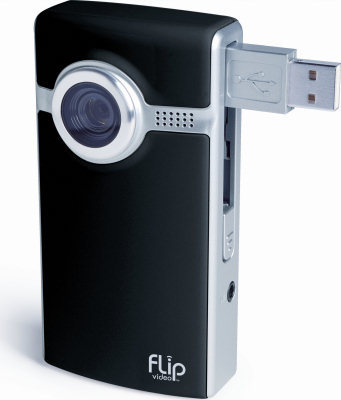The Tech Desk's Hottest New Toys

Projectors - We have Dell m409WX projectors for equipment checkout. They may be small and cute, but they pack a lot of punch too! Each projector comes with an AC power adapter and a VGA cable in a nifty carrying bag. These projectors also have an HDMI port and project in beautiful widescreen. Suitable for class presentations and dorm movie nights!

High-Definition Camcorders - We now stock Canon Vixia HV30 Camcorders which will record in stunning 1080i HD resolution (1920 x 1080 pixels). These are not for the faint of heart! With great quality comes great storage-eating capabilities. A project recorded in HD will take up four times as much disk space as regular DV footage, so beware. (One hour of HD footage will take about 50GB of space.) Most users only need our normal camcorders, so you must ask specifically for HD if you need it.
And finally, after Kenneth
 demonstrated this cute little device over a year ago. . .
demonstrated this cute little device over a year ago. . .Mini-Camcorders - We have Flip Video Ultra VGA Camcorders. They record at VGA resolution (640 x 480 pixels), as compared with the 720x480 resolution you get with the standard miniDV camcorders we offer. However, These Flips are pocket-sized and can be directly plugged into the USB port of any computer for file transfer! How cool is that? Ask us for a demo.
The New Deal: The Meyer Tech Desk Checkout Policies 2008
Ever needed a camcorder for more than a day, but had to turn it in because of the one-day only checkout policy? We now offer Extended Checkouts!
Anything you checkout normally from the Tech Desk is still due back by closing time of the next business day. However, now if you want to rent it for longer, you can pay up front for an Extended Checkout. It's $10/day for each piece of equipment you need beyond the initial free day, so plan carefully! Overdues will be result in a $15 fee per day per item.
Example: Qianwen wants to checkout a Flip Video Camcorder for her ski trip to Lake Tahoe. She checks out the camcorder on Friday morning, and won't be back on campus until Monday. She gets one free day (Friday to Saturday) and then pays $20 up front for Sunday and Monday. If she did not pay for an Extended Checkout, she would be fined $15 per overdue day, resulting in $30 of fines by the time she returns the equipment.
Next week, we'll be introducing some new faces at the Meyer Tech Desk. Stay tuned!



